A Comprehensive Report on Universal Health Care in Singapore
VerifiedAdded on 2020/03/16
|12
|3009
|454
Report
AI Summary
This report provides a detailed analysis of Singapore's universal health care system, highlighting its key principles, financing mechanisms, and the pivotal role played by the government. The report begins with an overview of Singapore's healthcare system, its global ranking, and its commitment to universal health coverage. It then explores the healthcare principles that facilitate universal coverage, emphasizing preventative health care strategies, the '3M' system (Medisave, Medishield, and Medifund), and the government's focus on cost-effectiveness. The report also delves into the government's role in shaping the healthcare landscape, including its funding schemes, incentivizing programs for healthcare providers, and the monitoring of key performance indicators. The report concludes by emphasizing Singapore's success in developing a comprehensive healthcare delivery system that serves as a model for other nations, incorporating financial protection, incentivization, and robust coverage monitoring.
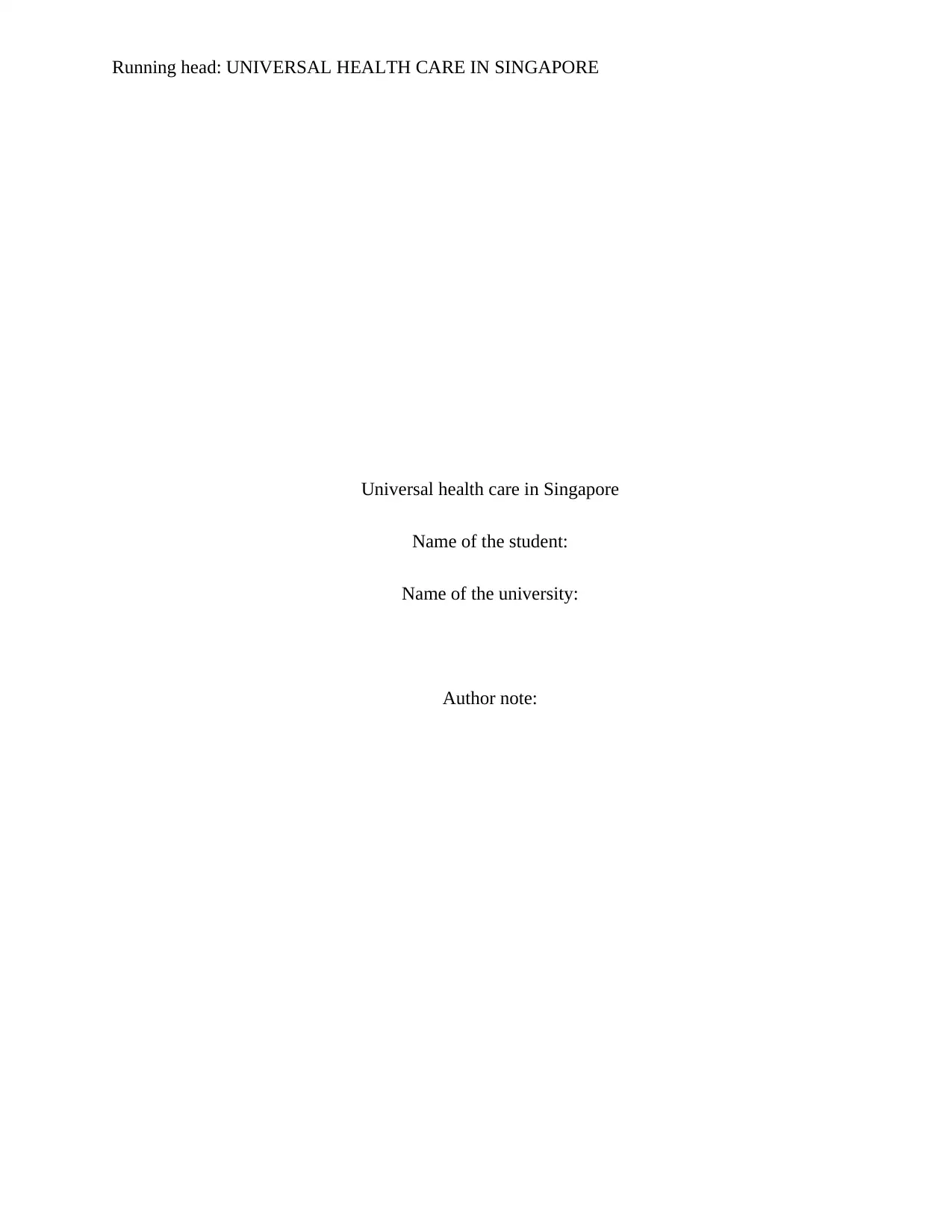
Running head: UNIVERSAL HEALTH CARE IN SINGAPORE
Universal health care in Singapore
Name of the student:
Name of the university:
Author note:
Universal health care in Singapore
Name of the student:
Name of the university:
Author note:
Paraphrase This Document
Need a fresh take? Get an instant paraphrase of this document with our AI Paraphraser
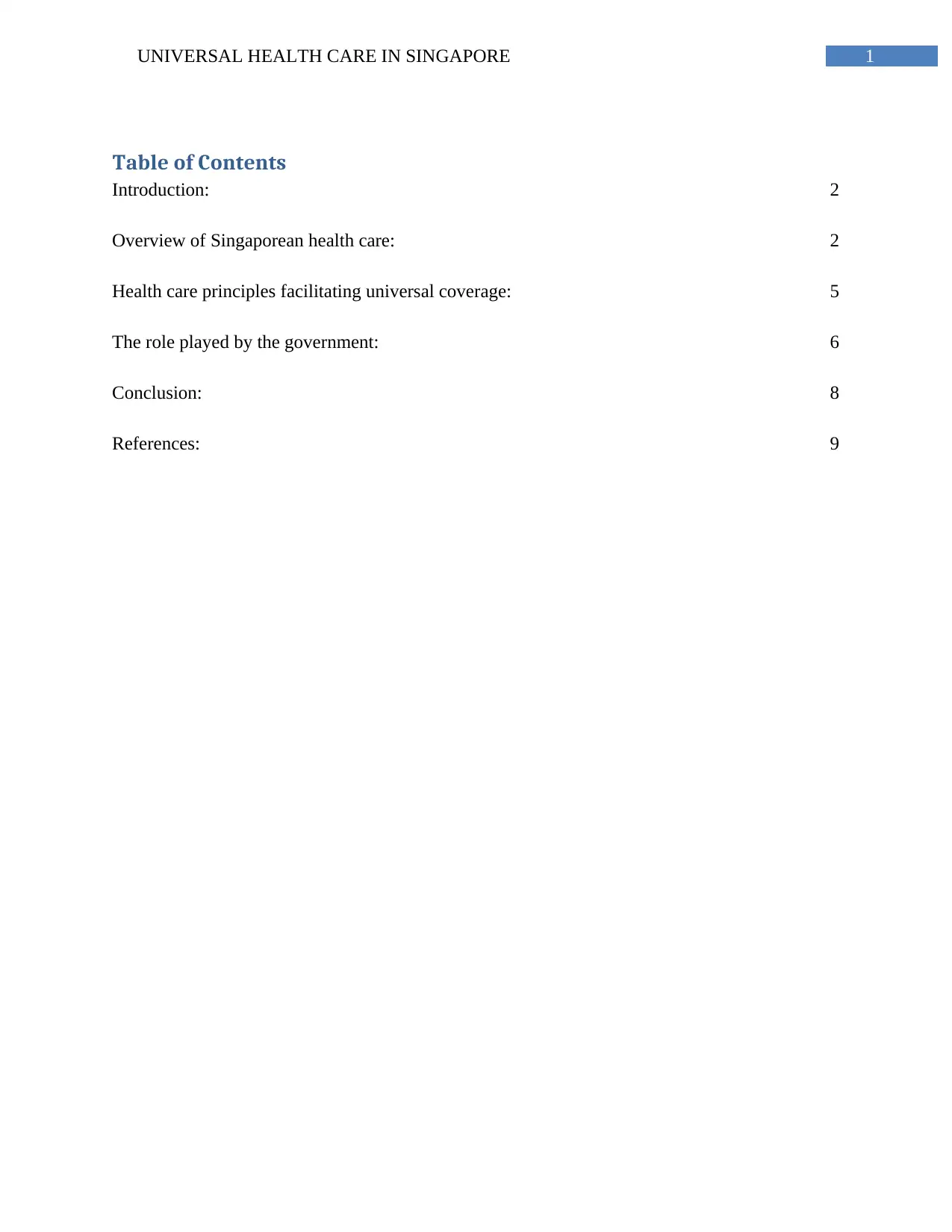
1UNIVERSAL HEALTH CARE IN SINGAPORE
Table of Contents
Introduction: 2
Overview of Singaporean health care: 2
Health care principles facilitating universal coverage: 5
The role played by the government: 6
Conclusion: 8
References: 9
Table of Contents
Introduction: 2
Overview of Singaporean health care: 2
Health care principles facilitating universal coverage: 5
The role played by the government: 6
Conclusion: 8
References: 9
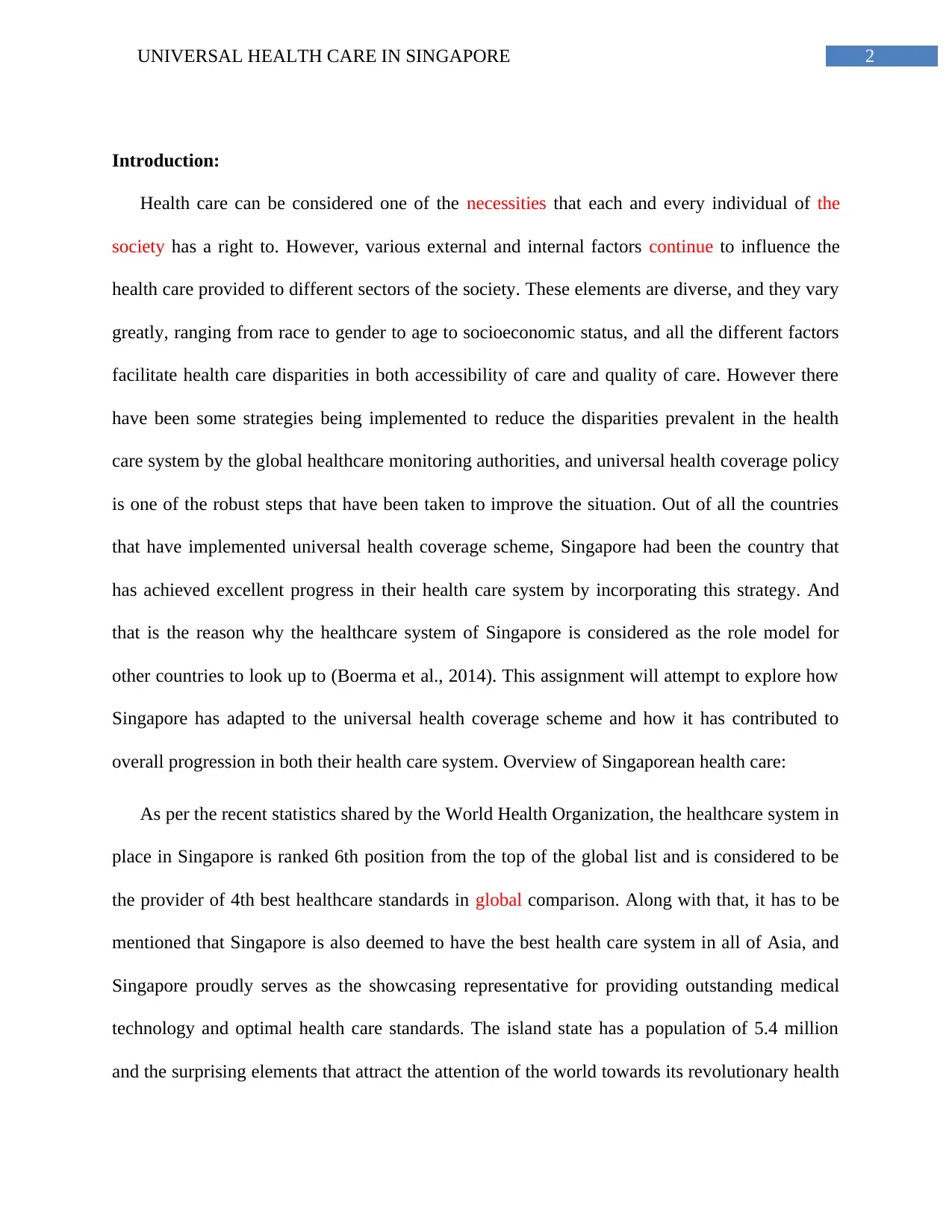
2UNIVERSAL HEALTH CARE IN SINGAPORE
Introduction:
Health care can be considered one of the necessities that each and every individual of the
society has a right to. However, various external and internal factors continue to influence the
health care provided to different sectors of the society. These elements are diverse, and they vary
greatly, ranging from race to gender to age to socioeconomic status, and all the different factors
facilitate health care disparities in both accessibility of care and quality of care. However there
have been some strategies being implemented to reduce the disparities prevalent in the health
care system by the global healthcare monitoring authorities, and universal health coverage policy
is one of the robust steps that have been taken to improve the situation. Out of all the countries
that have implemented universal health coverage scheme, Singapore had been the country that
has achieved excellent progress in their health care system by incorporating this strategy. And
that is the reason why the healthcare system of Singapore is considered as the role model for
other countries to look up to (Boerma et al., 2014). This assignment will attempt to explore how
Singapore has adapted to the universal health coverage scheme and how it has contributed to
overall progression in both their health care system. Overview of Singaporean health care:
As per the recent statistics shared by the World Health Organization, the healthcare system in
place in Singapore is ranked 6th position from the top of the global list and is considered to be
the provider of 4th best healthcare standards in global comparison. Along with that, it has to be
mentioned that Singapore is also deemed to have the best health care system in all of Asia, and
Singapore proudly serves as the showcasing representative for providing outstanding medical
technology and optimal health care standards. The island state has a population of 5.4 million
and the surprising elements that attract the attention of the world towards its revolutionary health
Introduction:
Health care can be considered one of the necessities that each and every individual of the
society has a right to. However, various external and internal factors continue to influence the
health care provided to different sectors of the society. These elements are diverse, and they vary
greatly, ranging from race to gender to age to socioeconomic status, and all the different factors
facilitate health care disparities in both accessibility of care and quality of care. However there
have been some strategies being implemented to reduce the disparities prevalent in the health
care system by the global healthcare monitoring authorities, and universal health coverage policy
is one of the robust steps that have been taken to improve the situation. Out of all the countries
that have implemented universal health coverage scheme, Singapore had been the country that
has achieved excellent progress in their health care system by incorporating this strategy. And
that is the reason why the healthcare system of Singapore is considered as the role model for
other countries to look up to (Boerma et al., 2014). This assignment will attempt to explore how
Singapore has adapted to the universal health coverage scheme and how it has contributed to
overall progression in both their health care system. Overview of Singaporean health care:
As per the recent statistics shared by the World Health Organization, the healthcare system in
place in Singapore is ranked 6th position from the top of the global list and is considered to be
the provider of 4th best healthcare standards in global comparison. Along with that, it has to be
mentioned that Singapore is also deemed to have the best health care system in all of Asia, and
Singapore proudly serves as the showcasing representative for providing outstanding medical
technology and optimal health care standards. The island state has a population of 5.4 million
and the surprising elements that attract the attention of the world towards its revolutionary health
⊘ This is a preview!⊘
Do you want full access?
Subscribe today to unlock all pages.

Trusted by 1+ million students worldwide
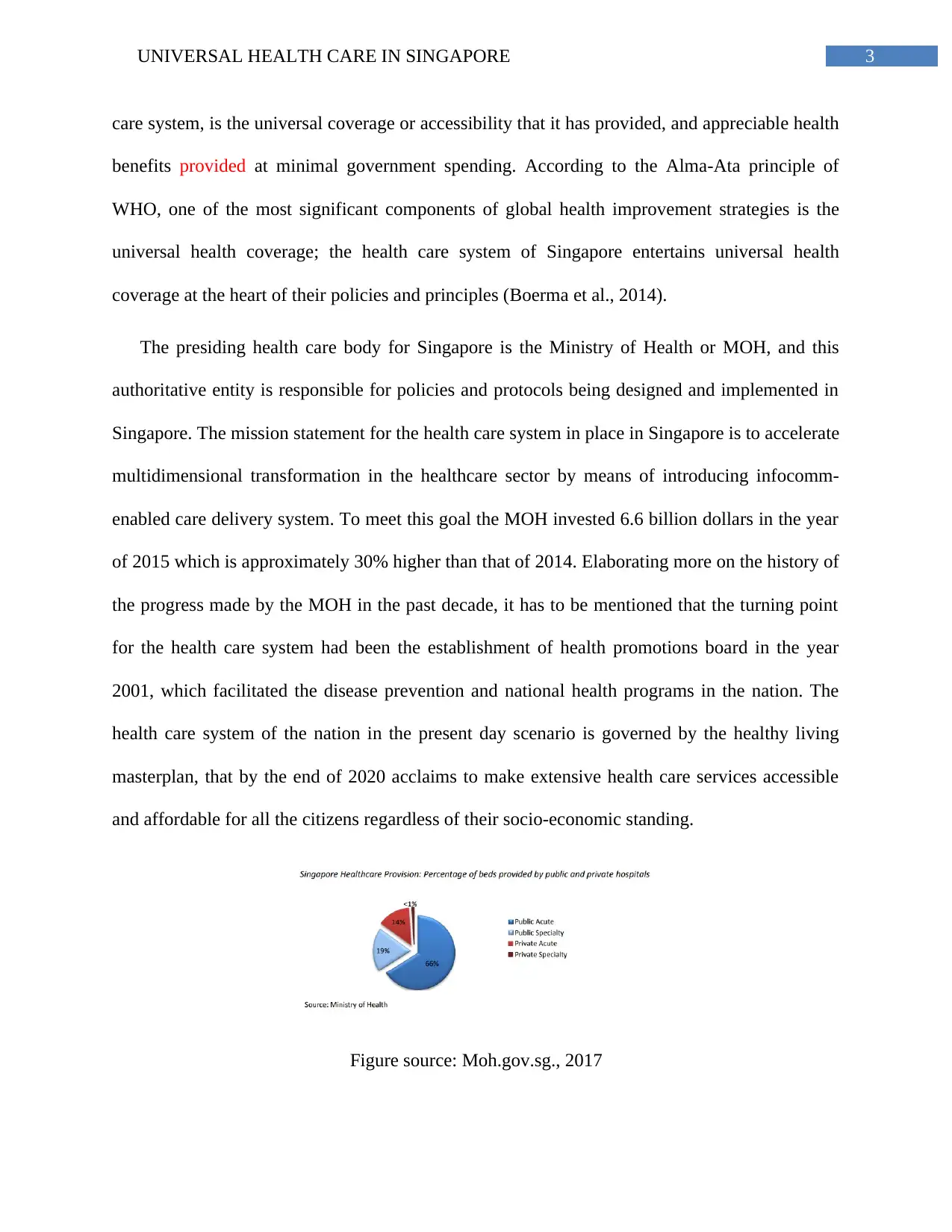
3UNIVERSAL HEALTH CARE IN SINGAPORE
care system, is the universal coverage or accessibility that it has provided, and appreciable health
benefits provided at minimal government spending. According to the Alma-Ata principle of
WHO, one of the most significant components of global health improvement strategies is the
universal health coverage; the health care system of Singapore entertains universal health
coverage at the heart of their policies and principles (Boerma et al., 2014).
The presiding health care body for Singapore is the Ministry of Health or MOH, and this
authoritative entity is responsible for policies and protocols being designed and implemented in
Singapore. The mission statement for the health care system in place in Singapore is to accelerate
multidimensional transformation in the healthcare sector by means of introducing infocomm-
enabled care delivery system. To meet this goal the MOH invested 6.6 billion dollars in the year
of 2015 which is approximately 30% higher than that of 2014. Elaborating more on the history of
the progress made by the MOH in the past decade, it has to be mentioned that the turning point
for the health care system had been the establishment of health promotions board in the year
2001, which facilitated the disease prevention and national health programs in the nation. The
health care system of the nation in the present day scenario is governed by the healthy living
masterplan, that by the end of 2020 acclaims to make extensive health care services accessible
and affordable for all the citizens regardless of their socio-economic standing.
Figure source: Moh.gov.sg., 2017
care system, is the universal coverage or accessibility that it has provided, and appreciable health
benefits provided at minimal government spending. According to the Alma-Ata principle of
WHO, one of the most significant components of global health improvement strategies is the
universal health coverage; the health care system of Singapore entertains universal health
coverage at the heart of their policies and principles (Boerma et al., 2014).
The presiding health care body for Singapore is the Ministry of Health or MOH, and this
authoritative entity is responsible for policies and protocols being designed and implemented in
Singapore. The mission statement for the health care system in place in Singapore is to accelerate
multidimensional transformation in the healthcare sector by means of introducing infocomm-
enabled care delivery system. To meet this goal the MOH invested 6.6 billion dollars in the year
of 2015 which is approximately 30% higher than that of 2014. Elaborating more on the history of
the progress made by the MOH in the past decade, it has to be mentioned that the turning point
for the health care system had been the establishment of health promotions board in the year
2001, which facilitated the disease prevention and national health programs in the nation. The
health care system of the nation in the present day scenario is governed by the healthy living
masterplan, that by the end of 2020 acclaims to make extensive health care services accessible
and affordable for all the citizens regardless of their socio-economic standing.
Figure source: Moh.gov.sg., 2017
Paraphrase This Document
Need a fresh take? Get an instant paraphrase of this document with our AI Paraphraser
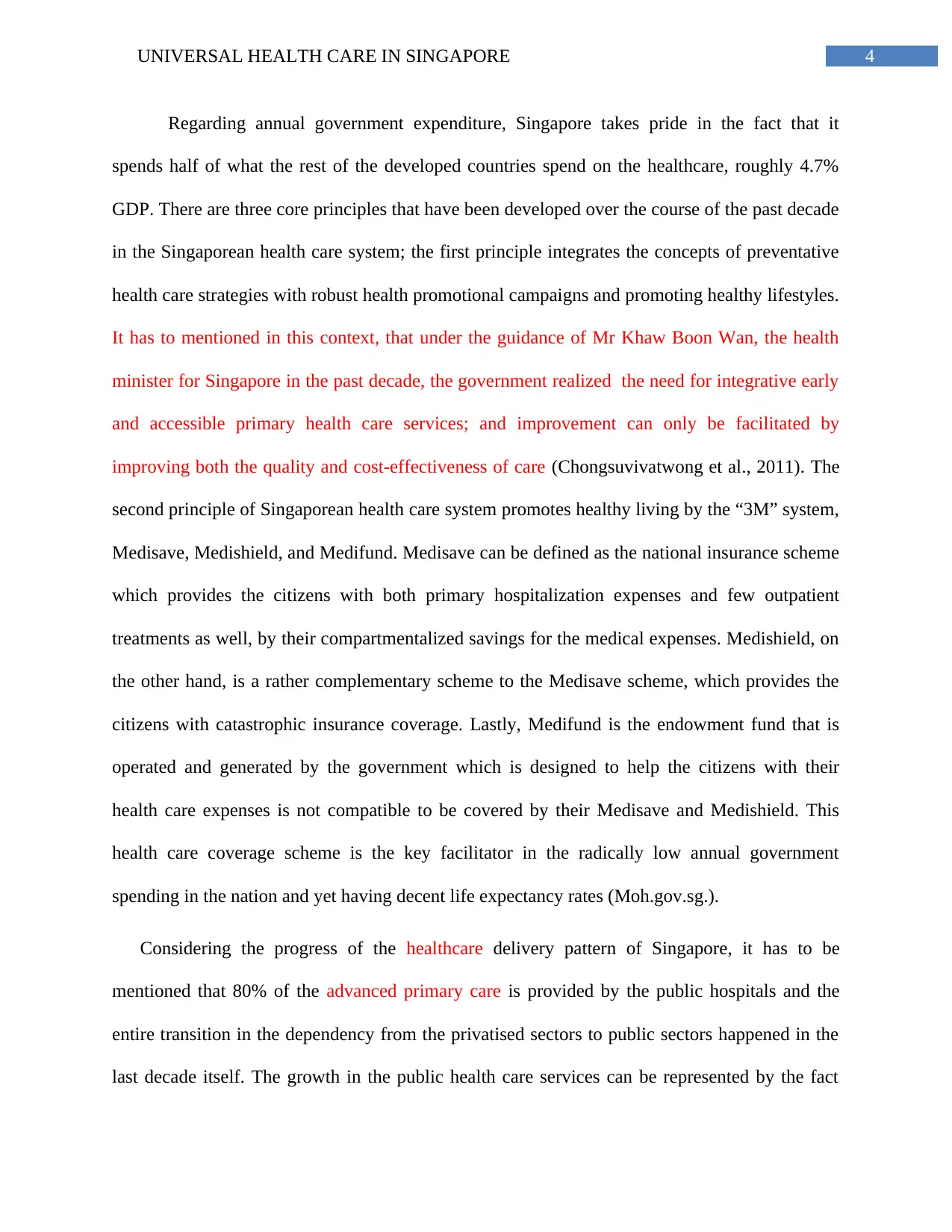
4UNIVERSAL HEALTH CARE IN SINGAPORE
Regarding annual government expenditure, Singapore takes pride in the fact that it
spends half of what the rest of the developed countries spend on the healthcare, roughly 4.7%
GDP. There are three core principles that have been developed over the course of the past decade
in the Singaporean health care system; the first principle integrates the concepts of preventative
health care strategies with robust health promotional campaigns and promoting healthy lifestyles.
It has to mentioned in this context, that under the guidance of Mr Khaw Boon Wan, the health
minister for Singapore in the past decade, the government realized the need for integrative early
and accessible primary health care services; and improvement can only be facilitated by
improving both the quality and cost-effectiveness of care (Chongsuvivatwong et al., 2011). The
second principle of Singaporean health care system promotes healthy living by the “3M” system,
Medisave, Medishield, and Medifund. Medisave can be defined as the national insurance scheme
which provides the citizens with both primary hospitalization expenses and few outpatient
treatments as well, by their compartmentalized savings for the medical expenses. Medishield, on
the other hand, is a rather complementary scheme to the Medisave scheme, which provides the
citizens with catastrophic insurance coverage. Lastly, Medifund is the endowment fund that is
operated and generated by the government which is designed to help the citizens with their
health care expenses is not compatible to be covered by their Medisave and Medishield. This
health care coverage scheme is the key facilitator in the radically low annual government
spending in the nation and yet having decent life expectancy rates (Moh.gov.sg.).
Considering the progress of the healthcare delivery pattern of Singapore, it has to be
mentioned that 80% of the advanced primary care is provided by the public hospitals and the
entire transition in the dependency from the privatised sectors to public sectors happened in the
last decade itself. The growth in the public health care services can be represented by the fact
Regarding annual government expenditure, Singapore takes pride in the fact that it
spends half of what the rest of the developed countries spend on the healthcare, roughly 4.7%
GDP. There are three core principles that have been developed over the course of the past decade
in the Singaporean health care system; the first principle integrates the concepts of preventative
health care strategies with robust health promotional campaigns and promoting healthy lifestyles.
It has to mentioned in this context, that under the guidance of Mr Khaw Boon Wan, the health
minister for Singapore in the past decade, the government realized the need for integrative early
and accessible primary health care services; and improvement can only be facilitated by
improving both the quality and cost-effectiveness of care (Chongsuvivatwong et al., 2011). The
second principle of Singaporean health care system promotes healthy living by the “3M” system,
Medisave, Medishield, and Medifund. Medisave can be defined as the national insurance scheme
which provides the citizens with both primary hospitalization expenses and few outpatient
treatments as well, by their compartmentalized savings for the medical expenses. Medishield, on
the other hand, is a rather complementary scheme to the Medisave scheme, which provides the
citizens with catastrophic insurance coverage. Lastly, Medifund is the endowment fund that is
operated and generated by the government which is designed to help the citizens with their
health care expenses is not compatible to be covered by their Medisave and Medishield. This
health care coverage scheme is the key facilitator in the radically low annual government
spending in the nation and yet having decent life expectancy rates (Moh.gov.sg.).
Considering the progress of the healthcare delivery pattern of Singapore, it has to be
mentioned that 80% of the advanced primary care is provided by the public hospitals and the
entire transition in the dependency from the privatised sectors to public sectors happened in the
last decade itself. The growth in the public health care services can be represented by the fact
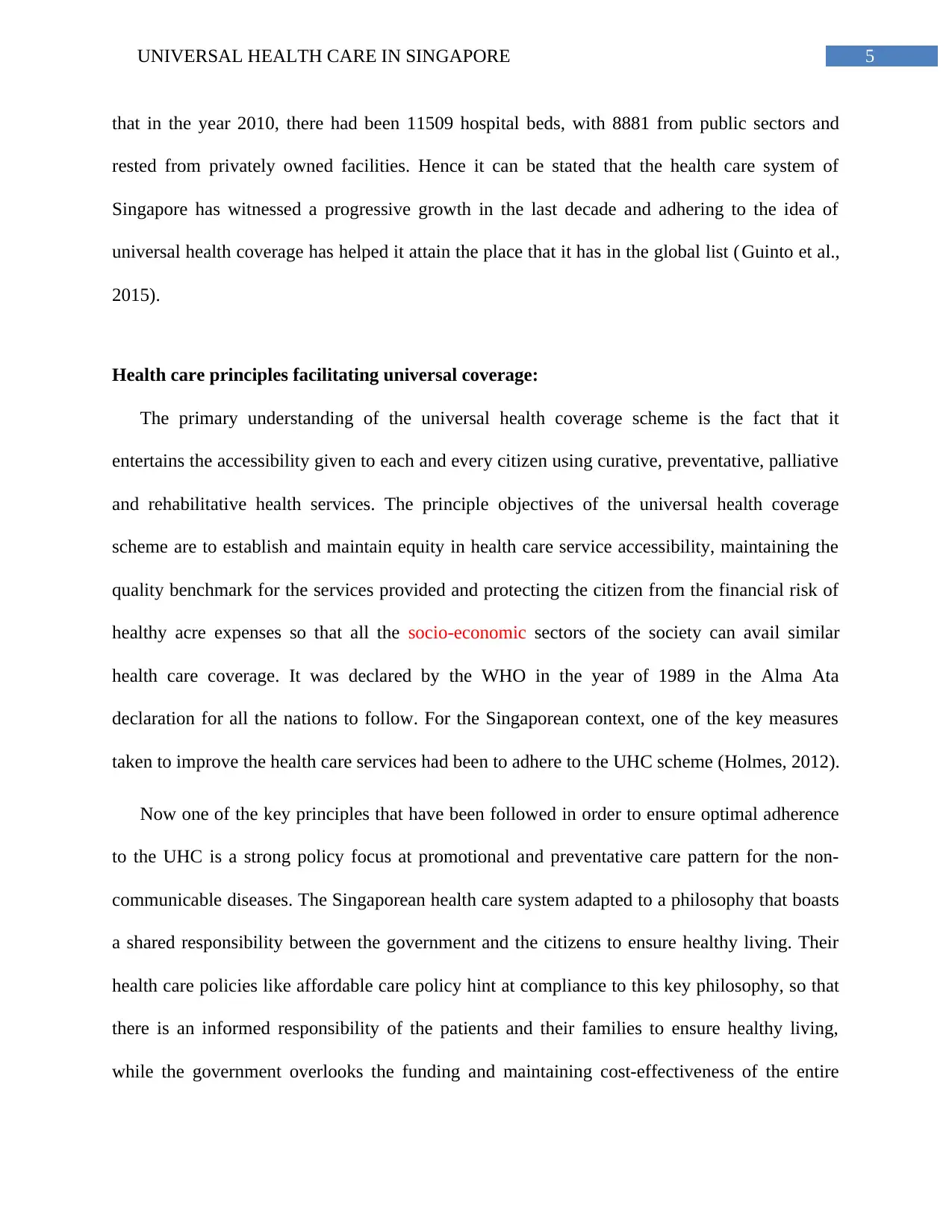
5UNIVERSAL HEALTH CARE IN SINGAPORE
that in the year 2010, there had been 11509 hospital beds, with 8881 from public sectors and
rested from privately owned facilities. Hence it can be stated that the health care system of
Singapore has witnessed a progressive growth in the last decade and adhering to the idea of
universal health coverage has helped it attain the place that it has in the global list ( Guinto et al.,
2015).
Health care principles facilitating universal coverage:
The primary understanding of the universal health coverage scheme is the fact that it
entertains the accessibility given to each and every citizen using curative, preventative, palliative
and rehabilitative health services. The principle objectives of the universal health coverage
scheme are to establish and maintain equity in health care service accessibility, maintaining the
quality benchmark for the services provided and protecting the citizen from the financial risk of
healthy acre expenses so that all the socio-economic sectors of the society can avail similar
health care coverage. It was declared by the WHO in the year of 1989 in the Alma Ata
declaration for all the nations to follow. For the Singaporean context, one of the key measures
taken to improve the health care services had been to adhere to the UHC scheme (Holmes, 2012).
Now one of the key principles that have been followed in order to ensure optimal adherence
to the UHC is a strong policy focus at promotional and preventative care pattern for the non-
communicable diseases. The Singaporean health care system adapted to a philosophy that boasts
a shared responsibility between the government and the citizens to ensure healthy living. Their
health care policies like affordable care policy hint at compliance to this key philosophy, so that
there is an informed responsibility of the patients and their families to ensure healthy living,
while the government overlooks the funding and maintaining cost-effectiveness of the entire
that in the year 2010, there had been 11509 hospital beds, with 8881 from public sectors and
rested from privately owned facilities. Hence it can be stated that the health care system of
Singapore has witnessed a progressive growth in the last decade and adhering to the idea of
universal health coverage has helped it attain the place that it has in the global list ( Guinto et al.,
2015).
Health care principles facilitating universal coverage:
The primary understanding of the universal health coverage scheme is the fact that it
entertains the accessibility given to each and every citizen using curative, preventative, palliative
and rehabilitative health services. The principle objectives of the universal health coverage
scheme are to establish and maintain equity in health care service accessibility, maintaining the
quality benchmark for the services provided and protecting the citizen from the financial risk of
healthy acre expenses so that all the socio-economic sectors of the society can avail similar
health care coverage. It was declared by the WHO in the year of 1989 in the Alma Ata
declaration for all the nations to follow. For the Singaporean context, one of the key measures
taken to improve the health care services had been to adhere to the UHC scheme (Holmes, 2012).
Now one of the key principles that have been followed in order to ensure optimal adherence
to the UHC is a strong policy focus at promotional and preventative care pattern for the non-
communicable diseases. The Singaporean health care system adapted to a philosophy that boasts
a shared responsibility between the government and the citizens to ensure healthy living. Their
health care policies like affordable care policy hint at compliance to this key philosophy, so that
there is an informed responsibility of the patients and their families to ensure healthy living,
while the government overlooks the funding and maintaining cost-effectiveness of the entire
⊘ This is a preview!⊘
Do you want full access?
Subscribe today to unlock all pages.

Trusted by 1+ million students worldwide
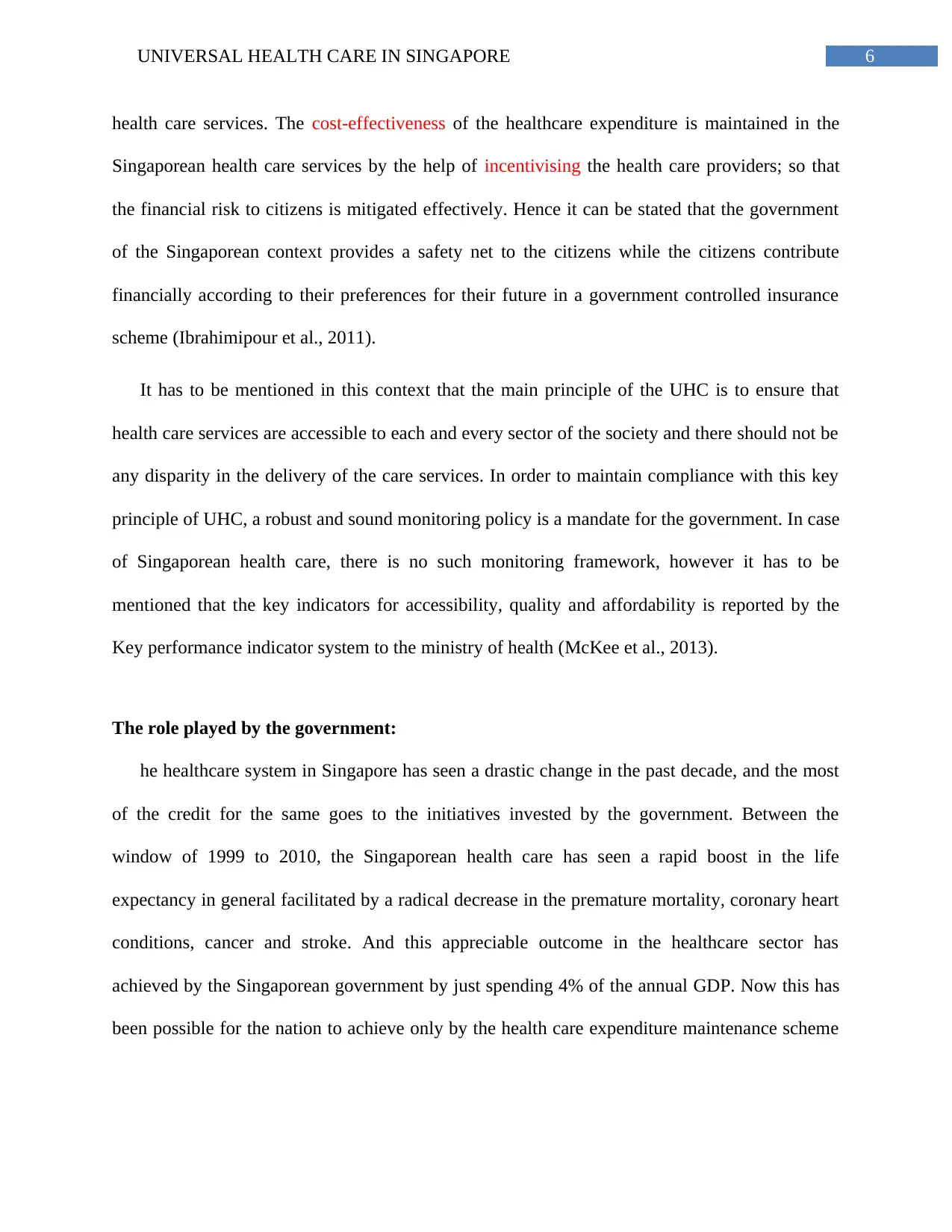
6UNIVERSAL HEALTH CARE IN SINGAPORE
health care services. The cost-effectiveness of the healthcare expenditure is maintained in the
Singaporean health care services by the help of incentivising the health care providers; so that
the financial risk to citizens is mitigated effectively. Hence it can be stated that the government
of the Singaporean context provides a safety net to the citizens while the citizens contribute
financially according to their preferences for their future in a government controlled insurance
scheme (Ibrahimipour et al., 2011).
It has to be mentioned in this context that the main principle of the UHC is to ensure that
health care services are accessible to each and every sector of the society and there should not be
any disparity in the delivery of the care services. In order to maintain compliance with this key
principle of UHC, a robust and sound monitoring policy is a mandate for the government. In case
of Singaporean health care, there is no such monitoring framework, however it has to be
mentioned that the key indicators for accessibility, quality and affordability is reported by the
Key performance indicator system to the ministry of health (McKee et al., 2013).
The role played by the government:
he healthcare system in Singapore has seen a drastic change in the past decade, and the most
of the credit for the same goes to the initiatives invested by the government. Between the
window of 1999 to 2010, the Singaporean health care has seen a rapid boost in the life
expectancy in general facilitated by a radical decrease in the premature mortality, coronary heart
conditions, cancer and stroke. And this appreciable outcome in the healthcare sector has
achieved by the Singaporean government by just spending 4% of the annual GDP. Now this has
been possible for the nation to achieve only by the health care expenditure maintenance scheme
health care services. The cost-effectiveness of the healthcare expenditure is maintained in the
Singaporean health care services by the help of incentivising the health care providers; so that
the financial risk to citizens is mitigated effectively. Hence it can be stated that the government
of the Singaporean context provides a safety net to the citizens while the citizens contribute
financially according to their preferences for their future in a government controlled insurance
scheme (Ibrahimipour et al., 2011).
It has to be mentioned in this context that the main principle of the UHC is to ensure that
health care services are accessible to each and every sector of the society and there should not be
any disparity in the delivery of the care services. In order to maintain compliance with this key
principle of UHC, a robust and sound monitoring policy is a mandate for the government. In case
of Singaporean health care, there is no such monitoring framework, however it has to be
mentioned that the key indicators for accessibility, quality and affordability is reported by the
Key performance indicator system to the ministry of health (McKee et al., 2013).
The role played by the government:
he healthcare system in Singapore has seen a drastic change in the past decade, and the most
of the credit for the same goes to the initiatives invested by the government. Between the
window of 1999 to 2010, the Singaporean health care has seen a rapid boost in the life
expectancy in general facilitated by a radical decrease in the premature mortality, coronary heart
conditions, cancer and stroke. And this appreciable outcome in the healthcare sector has
achieved by the Singaporean government by just spending 4% of the annual GDP. Now this has
been possible for the nation to achieve only by the health care expenditure maintenance scheme
Paraphrase This Document
Need a fresh take? Get an instant paraphrase of this document with our AI Paraphraser
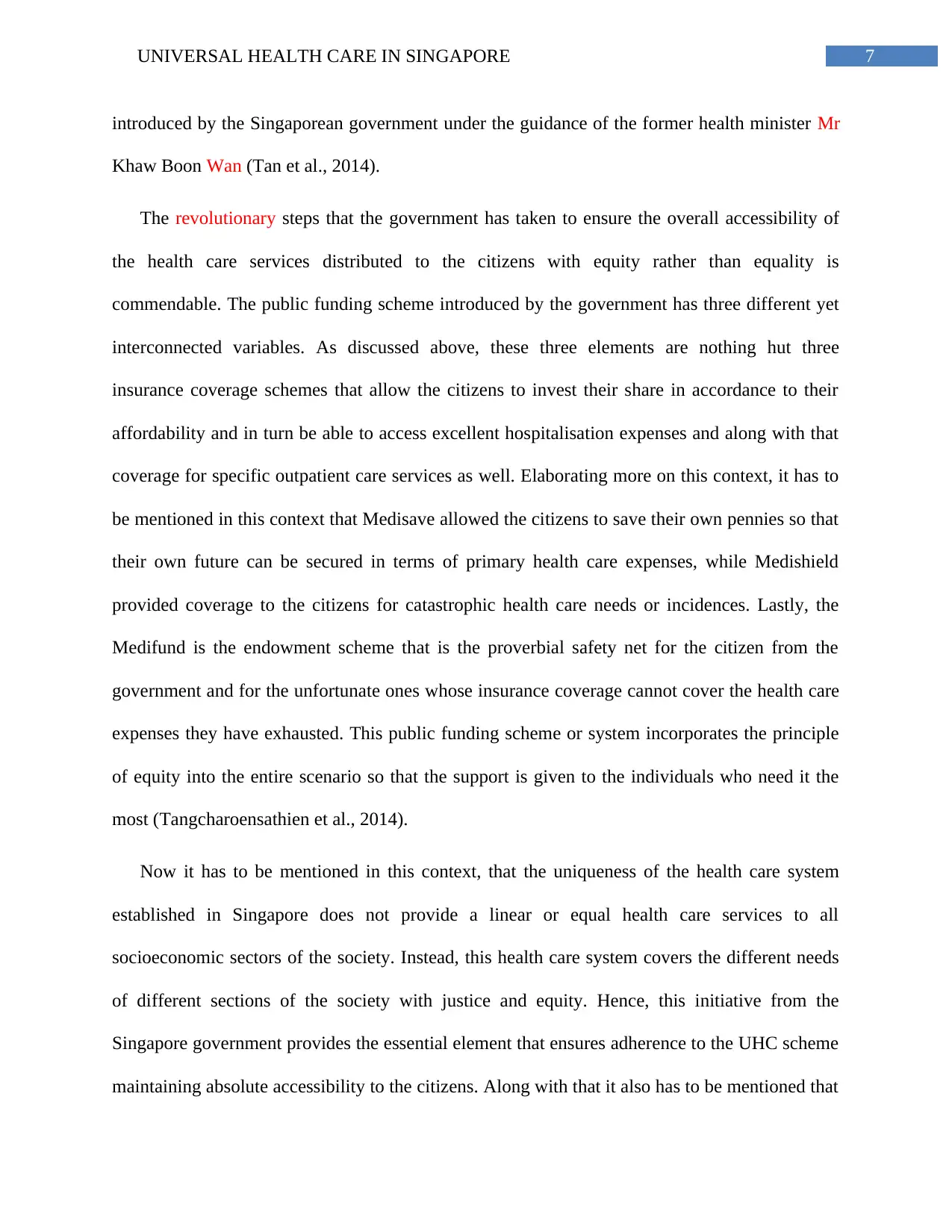
7UNIVERSAL HEALTH CARE IN SINGAPORE
introduced by the Singaporean government under the guidance of the former health minister Mr
Khaw Boon Wan (Tan et al., 2014).
The revolutionary steps that the government has taken to ensure the overall accessibility of
the health care services distributed to the citizens with equity rather than equality is
commendable. The public funding scheme introduced by the government has three different yet
interconnected variables. As discussed above, these three elements are nothing hut three
insurance coverage schemes that allow the citizens to invest their share in accordance to their
affordability and in turn be able to access excellent hospitalisation expenses and along with that
coverage for specific outpatient care services as well. Elaborating more on this context, it has to
be mentioned in this context that Medisave allowed the citizens to save their own pennies so that
their own future can be secured in terms of primary health care expenses, while Medishield
provided coverage to the citizens for catastrophic health care needs or incidences. Lastly, the
Medifund is the endowment scheme that is the proverbial safety net for the citizen from the
government and for the unfortunate ones whose insurance coverage cannot cover the health care
expenses they have exhausted. This public funding scheme or system incorporates the principle
of equity into the entire scenario so that the support is given to the individuals who need it the
most (Tangcharoensathien et al., 2014).
Now it has to be mentioned in this context, that the uniqueness of the health care system
established in Singapore does not provide a linear or equal health care services to all
socioeconomic sectors of the society. Instead, this health care system covers the different needs
of different sections of the society with justice and equity. Hence, this initiative from the
Singapore government provides the essential element that ensures adherence to the UHC scheme
maintaining absolute accessibility to the citizens. Along with that it also has to be mentioned that
introduced by the Singaporean government under the guidance of the former health minister Mr
Khaw Boon Wan (Tan et al., 2014).
The revolutionary steps that the government has taken to ensure the overall accessibility of
the health care services distributed to the citizens with equity rather than equality is
commendable. The public funding scheme introduced by the government has three different yet
interconnected variables. As discussed above, these three elements are nothing hut three
insurance coverage schemes that allow the citizens to invest their share in accordance to their
affordability and in turn be able to access excellent hospitalisation expenses and along with that
coverage for specific outpatient care services as well. Elaborating more on this context, it has to
be mentioned in this context that Medisave allowed the citizens to save their own pennies so that
their own future can be secured in terms of primary health care expenses, while Medishield
provided coverage to the citizens for catastrophic health care needs or incidences. Lastly, the
Medifund is the endowment scheme that is the proverbial safety net for the citizen from the
government and for the unfortunate ones whose insurance coverage cannot cover the health care
expenses they have exhausted. This public funding scheme or system incorporates the principle
of equity into the entire scenario so that the support is given to the individuals who need it the
most (Tangcharoensathien et al., 2014).
Now it has to be mentioned in this context, that the uniqueness of the health care system
established in Singapore does not provide a linear or equal health care services to all
socioeconomic sectors of the society. Instead, this health care system covers the different needs
of different sections of the society with justice and equity. Hence, this initiative from the
Singapore government provides the essential element that ensures adherence to the UHC scheme
maintaining absolute accessibility to the citizens. Along with that it also has to be mentioned that
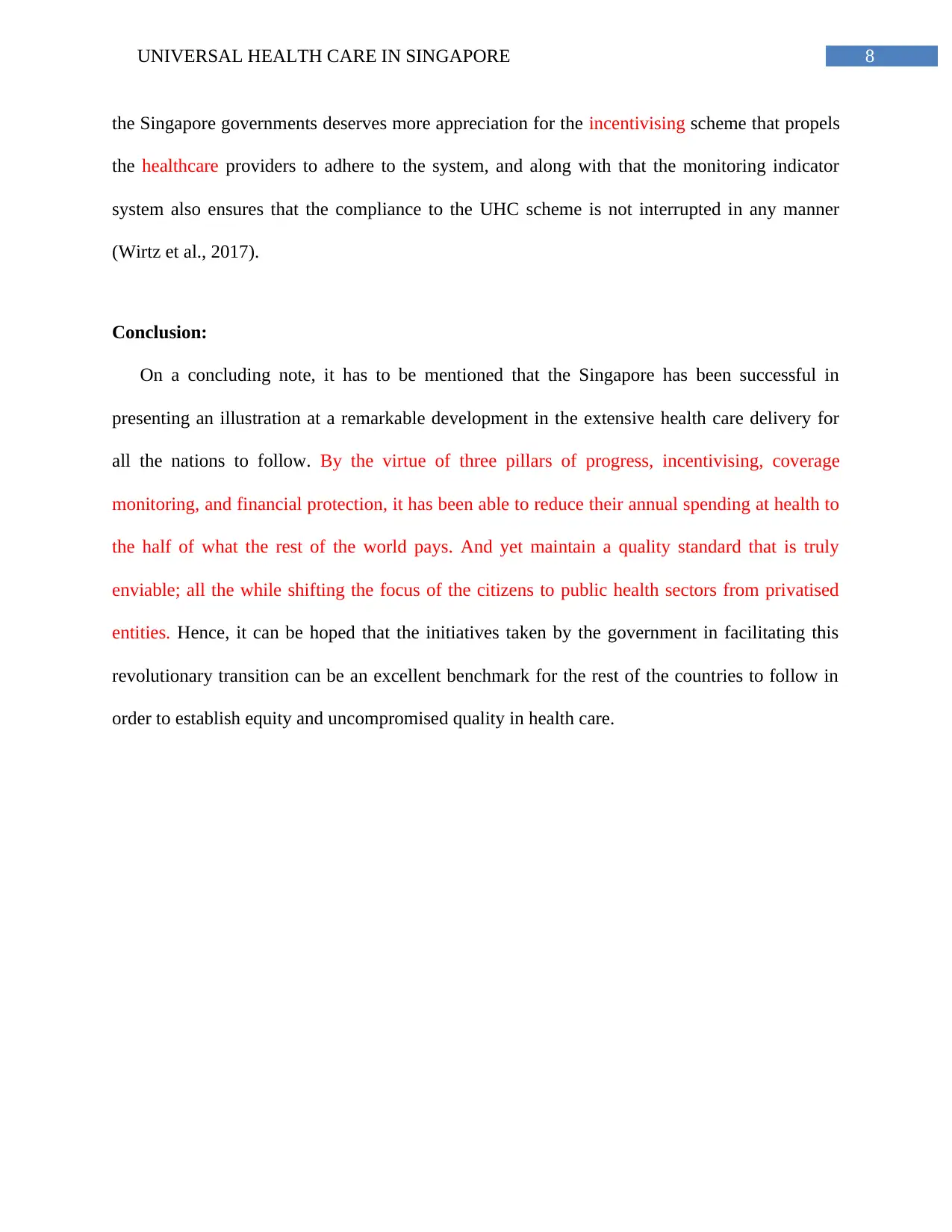
8UNIVERSAL HEALTH CARE IN SINGAPORE
the Singapore governments deserves more appreciation for the incentivising scheme that propels
the healthcare providers to adhere to the system, and along with that the monitoring indicator
system also ensures that the compliance to the UHC scheme is not interrupted in any manner
(Wirtz et al., 2017).
Conclusion:
On a concluding note, it has to be mentioned that the Singapore has been successful in
presenting an illustration at a remarkable development in the extensive health care delivery for
all the nations to follow. By the virtue of three pillars of progress, incentivising, coverage
monitoring, and financial protection, it has been able to reduce their annual spending at health to
the half of what the rest of the world pays. And yet maintain a quality standard that is truly
enviable; all the while shifting the focus of the citizens to public health sectors from privatised
entities. Hence, it can be hoped that the initiatives taken by the government in facilitating this
revolutionary transition can be an excellent benchmark for the rest of the countries to follow in
order to establish equity and uncompromised quality in health care.
the Singapore governments deserves more appreciation for the incentivising scheme that propels
the healthcare providers to adhere to the system, and along with that the monitoring indicator
system also ensures that the compliance to the UHC scheme is not interrupted in any manner
(Wirtz et al., 2017).
Conclusion:
On a concluding note, it has to be mentioned that the Singapore has been successful in
presenting an illustration at a remarkable development in the extensive health care delivery for
all the nations to follow. By the virtue of three pillars of progress, incentivising, coverage
monitoring, and financial protection, it has been able to reduce their annual spending at health to
the half of what the rest of the world pays. And yet maintain a quality standard that is truly
enviable; all the while shifting the focus of the citizens to public health sectors from privatised
entities. Hence, it can be hoped that the initiatives taken by the government in facilitating this
revolutionary transition can be an excellent benchmark for the rest of the countries to follow in
order to establish equity and uncompromised quality in health care.
⊘ This is a preview!⊘
Do you want full access?
Subscribe today to unlock all pages.

Trusted by 1+ million students worldwide
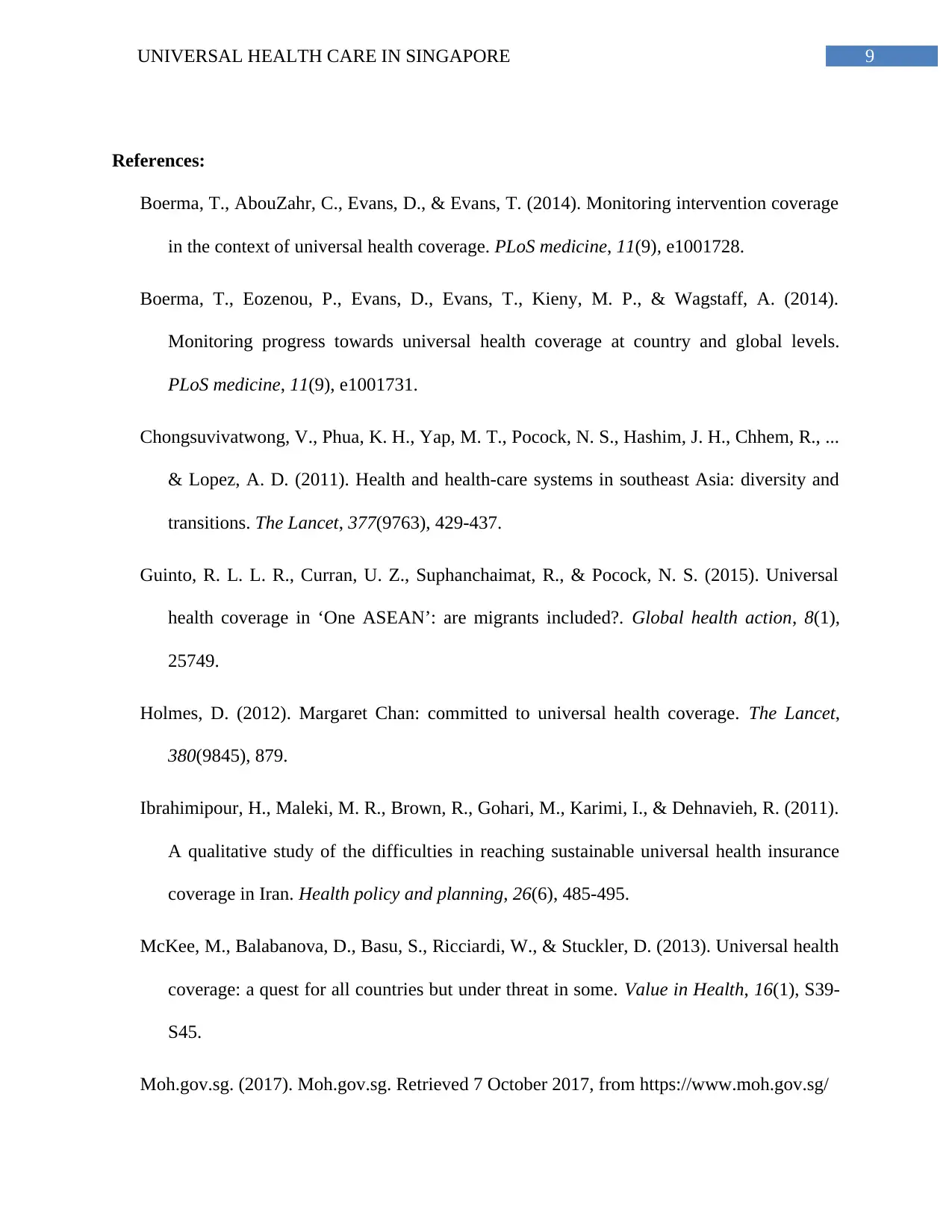
9UNIVERSAL HEALTH CARE IN SINGAPORE
References:
Boerma, T., AbouZahr, C., Evans, D., & Evans, T. (2014). Monitoring intervention coverage
in the context of universal health coverage. PLoS medicine, 11(9), e1001728.
Boerma, T., Eozenou, P., Evans, D., Evans, T., Kieny, M. P., & Wagstaff, A. (2014).
Monitoring progress towards universal health coverage at country and global levels.
PLoS medicine, 11(9), e1001731.
Chongsuvivatwong, V., Phua, K. H., Yap, M. T., Pocock, N. S., Hashim, J. H., Chhem, R., ...
& Lopez, A. D. (2011). Health and health-care systems in southeast Asia: diversity and
transitions. The Lancet, 377(9763), 429-437.
Guinto, R. L. L. R., Curran, U. Z., Suphanchaimat, R., & Pocock, N. S. (2015). Universal
health coverage in ‘One ASEAN’: are migrants included?. Global health action, 8(1),
25749.
Holmes, D. (2012). Margaret Chan: committed to universal health coverage. The Lancet,
380(9845), 879.
Ibrahimipour, H., Maleki, M. R., Brown, R., Gohari, M., Karimi, I., & Dehnavieh, R. (2011).
A qualitative study of the difficulties in reaching sustainable universal health insurance
coverage in Iran. Health policy and planning, 26(6), 485-495.
McKee, M., Balabanova, D., Basu, S., Ricciardi, W., & Stuckler, D. (2013). Universal health
coverage: a quest for all countries but under threat in some. Value in Health, 16(1), S39-
S45.
Moh.gov.sg. (2017). Moh.gov.sg. Retrieved 7 October 2017, from https://www.moh.gov.sg/
References:
Boerma, T., AbouZahr, C., Evans, D., & Evans, T. (2014). Monitoring intervention coverage
in the context of universal health coverage. PLoS medicine, 11(9), e1001728.
Boerma, T., Eozenou, P., Evans, D., Evans, T., Kieny, M. P., & Wagstaff, A. (2014).
Monitoring progress towards universal health coverage at country and global levels.
PLoS medicine, 11(9), e1001731.
Chongsuvivatwong, V., Phua, K. H., Yap, M. T., Pocock, N. S., Hashim, J. H., Chhem, R., ...
& Lopez, A. D. (2011). Health and health-care systems in southeast Asia: diversity and
transitions. The Lancet, 377(9763), 429-437.
Guinto, R. L. L. R., Curran, U. Z., Suphanchaimat, R., & Pocock, N. S. (2015). Universal
health coverage in ‘One ASEAN’: are migrants included?. Global health action, 8(1),
25749.
Holmes, D. (2012). Margaret Chan: committed to universal health coverage. The Lancet,
380(9845), 879.
Ibrahimipour, H., Maleki, M. R., Brown, R., Gohari, M., Karimi, I., & Dehnavieh, R. (2011).
A qualitative study of the difficulties in reaching sustainable universal health insurance
coverage in Iran. Health policy and planning, 26(6), 485-495.
McKee, M., Balabanova, D., Basu, S., Ricciardi, W., & Stuckler, D. (2013). Universal health
coverage: a quest for all countries but under threat in some. Value in Health, 16(1), S39-
S45.
Moh.gov.sg. (2017). Moh.gov.sg. Retrieved 7 October 2017, from https://www.moh.gov.sg/
Paraphrase This Document
Need a fresh take? Get an instant paraphrase of this document with our AI Paraphraser
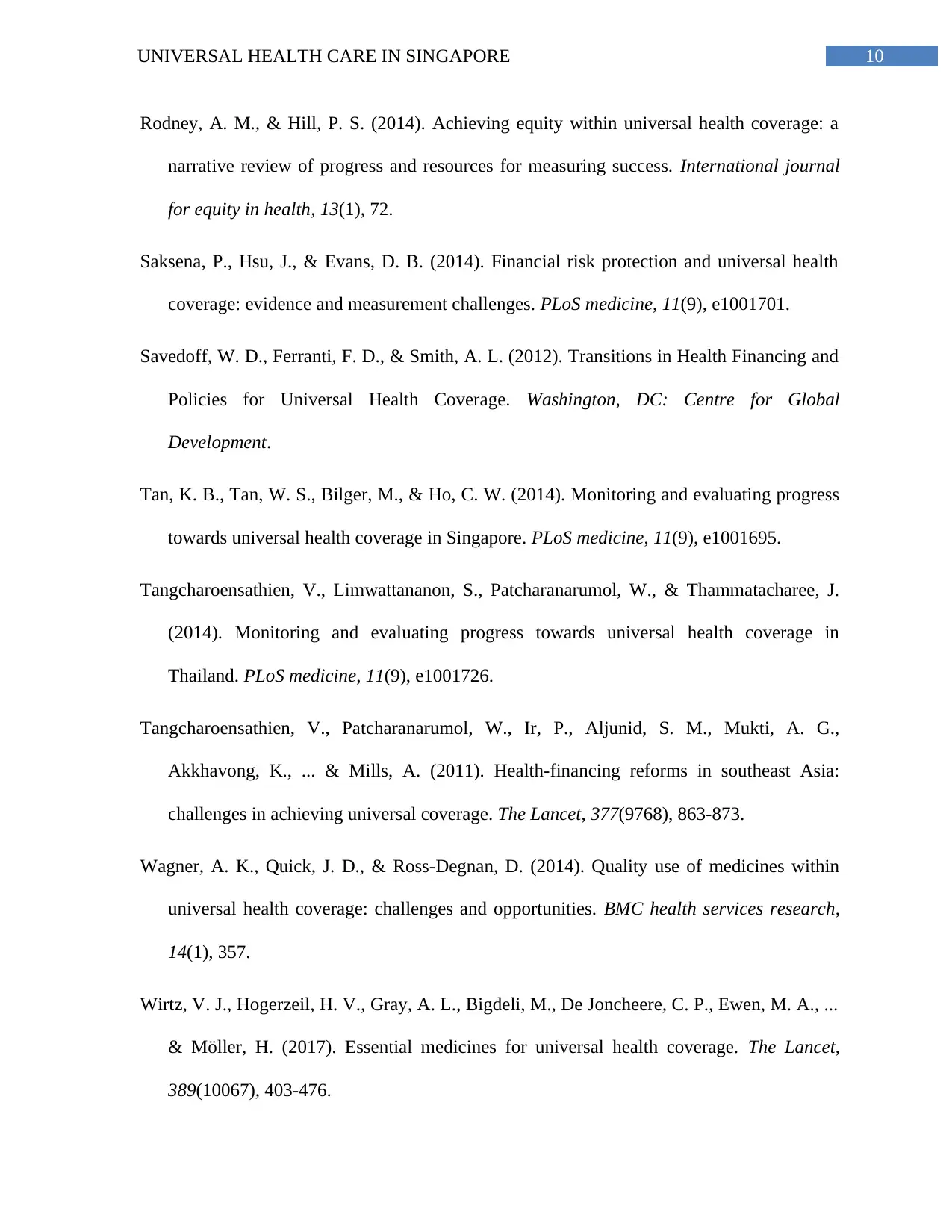
10UNIVERSAL HEALTH CARE IN SINGAPORE
Rodney, A. M., & Hill, P. S. (2014). Achieving equity within universal health coverage: a
narrative review of progress and resources for measuring success. International journal
for equity in health, 13(1), 72.
Saksena, P., Hsu, J., & Evans, D. B. (2014). Financial risk protection and universal health
coverage: evidence and measurement challenges. PLoS medicine, 11(9), e1001701.
Savedoff, W. D., Ferranti, F. D., & Smith, A. L. (2012). Transitions in Health Financing and
Policies for Universal Health Coverage. Washington, DC: Centre for Global
Development.
Tan, K. B., Tan, W. S., Bilger, M., & Ho, C. W. (2014). Monitoring and evaluating progress
towards universal health coverage in Singapore. PLoS medicine, 11(9), e1001695.
Tangcharoensathien, V., Limwattananon, S., Patcharanarumol, W., & Thammatacharee, J.
(2014). Monitoring and evaluating progress towards universal health coverage in
Thailand. PLoS medicine, 11(9), e1001726.
Tangcharoensathien, V., Patcharanarumol, W., Ir, P., Aljunid, S. M., Mukti, A. G.,
Akkhavong, K., ... & Mills, A. (2011). Health-financing reforms in southeast Asia:
challenges in achieving universal coverage. The Lancet, 377(9768), 863-873.
Wagner, A. K., Quick, J. D., & Ross-Degnan, D. (2014). Quality use of medicines within
universal health coverage: challenges and opportunities. BMC health services research,
14(1), 357.
Wirtz, V. J., Hogerzeil, H. V., Gray, A. L., Bigdeli, M., De Joncheere, C. P., Ewen, M. A., ...
& Möller, H. (2017). Essential medicines for universal health coverage. The Lancet,
389(10067), 403-476.
Rodney, A. M., & Hill, P. S. (2014). Achieving equity within universal health coverage: a
narrative review of progress and resources for measuring success. International journal
for equity in health, 13(1), 72.
Saksena, P., Hsu, J., & Evans, D. B. (2014). Financial risk protection and universal health
coverage: evidence and measurement challenges. PLoS medicine, 11(9), e1001701.
Savedoff, W. D., Ferranti, F. D., & Smith, A. L. (2012). Transitions in Health Financing and
Policies for Universal Health Coverage. Washington, DC: Centre for Global
Development.
Tan, K. B., Tan, W. S., Bilger, M., & Ho, C. W. (2014). Monitoring and evaluating progress
towards universal health coverage in Singapore. PLoS medicine, 11(9), e1001695.
Tangcharoensathien, V., Limwattananon, S., Patcharanarumol, W., & Thammatacharee, J.
(2014). Monitoring and evaluating progress towards universal health coverage in
Thailand. PLoS medicine, 11(9), e1001726.
Tangcharoensathien, V., Patcharanarumol, W., Ir, P., Aljunid, S. M., Mukti, A. G.,
Akkhavong, K., ... & Mills, A. (2011). Health-financing reforms in southeast Asia:
challenges in achieving universal coverage. The Lancet, 377(9768), 863-873.
Wagner, A. K., Quick, J. D., & Ross-Degnan, D. (2014). Quality use of medicines within
universal health coverage: challenges and opportunities. BMC health services research,
14(1), 357.
Wirtz, V. J., Hogerzeil, H. V., Gray, A. L., Bigdeli, M., De Joncheere, C. P., Ewen, M. A., ...
& Möller, H. (2017). Essential medicines for universal health coverage. The Lancet,
389(10067), 403-476.
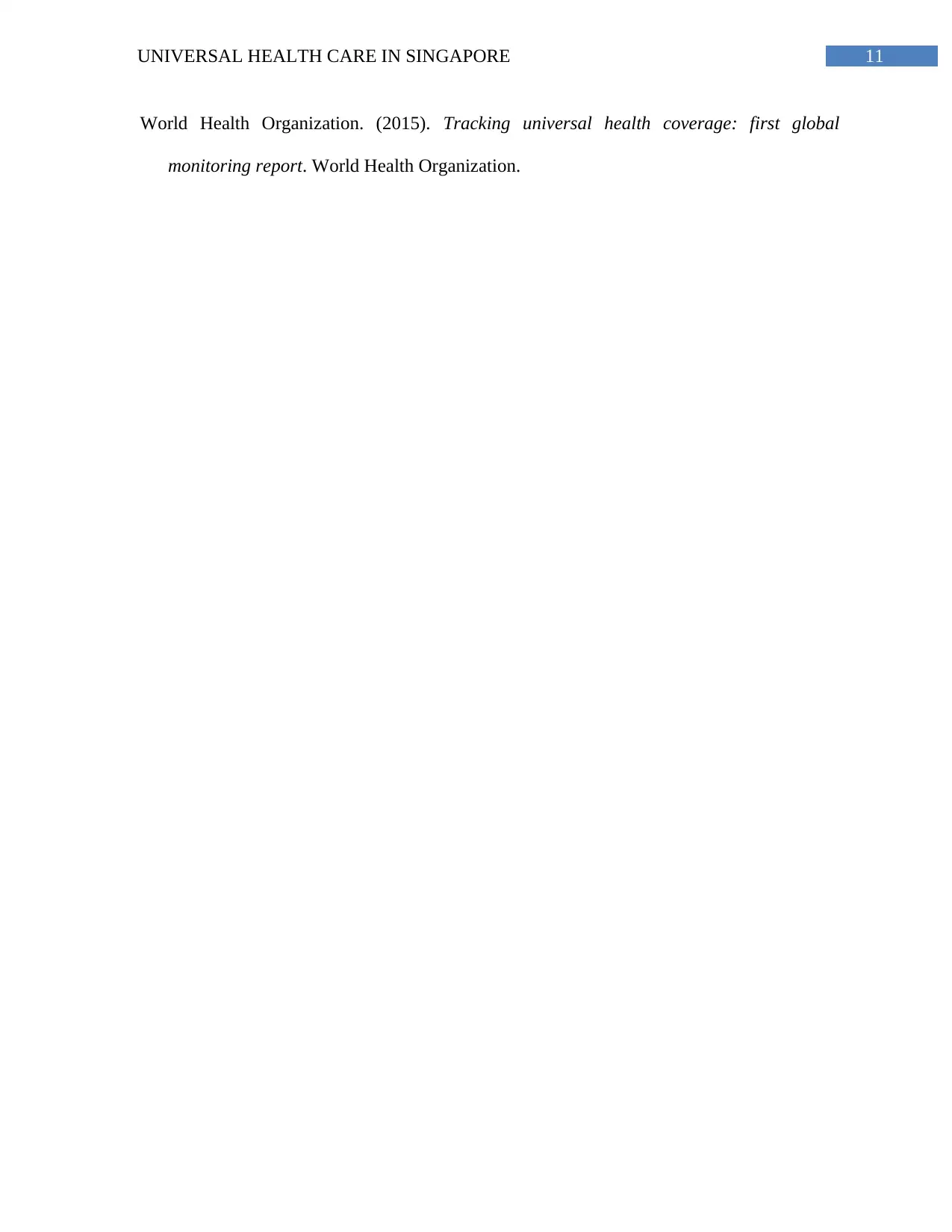
11UNIVERSAL HEALTH CARE IN SINGAPORE
World Health Organization. (2015). Tracking universal health coverage: first global
monitoring report. World Health Organization.
World Health Organization. (2015). Tracking universal health coverage: first global
monitoring report. World Health Organization.
⊘ This is a preview!⊘
Do you want full access?
Subscribe today to unlock all pages.

Trusted by 1+ million students worldwide
1 out of 12
Related Documents
Your All-in-One AI-Powered Toolkit for Academic Success.
+13062052269
info@desklib.com
Available 24*7 on WhatsApp / Email
![[object Object]](/_next/static/media/star-bottom.7253800d.svg)
Unlock your academic potential
Copyright © 2020–2025 A2Z Services. All Rights Reserved. Developed and managed by ZUCOL.





